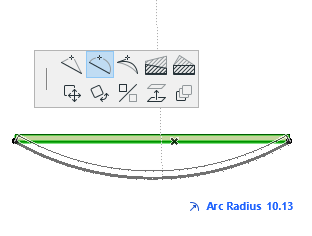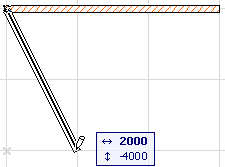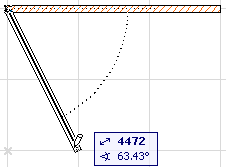Coordinate values are displayed in the Tracker, which follows your mouse movements and is available in any editable window type.
The Tracker gives you dynamic feedback on such values as edited lengths, angles, and hotspot values for GDL Object editing.
Also use the Tracker to input elements by defined values.
See Element Input Using Tracker.
Show Tracker
Do one of the following:
•Activate the Tracker toggle on the Standard toolbar
![]()
•Use the N shortcut. The Tracker will pop up and display the cursor position.
•Check Show Tracker in Options > Work Environment > Tracker and Coordinate Input. Here, you can also set Tracker colors, contents and behavior.
Some Tracker options are accessible from the pop-up arrow next to the Tracker toggle in the toolbar.
![]()
When placing a new element, you can define its coordinates in the Tracker.
With the Tracker displayed, do one of the following:
•Start typing a value for the default parameter (the one shown in bold).
Note: This input method works if the “Enable direct input into Tracker fields” box is checked in Options > Work Environment > Tracker and Coordinate Input. This is the default setting.
•Press Tab as many times as needed to activate the required Tracker field, then type in the desired number.
![]()
•Click a field in the Tracker to activate it, then type in the desired number.
•Type a shortcut (X, Y, Z or D/R or A) to activate the corresponding Tracker field, immediately followed by the value. For example: X3 or Y-4.
Notes:
–This input method works if the “Coordinate Shortcuts prefer Tracker” box is checked in Options > Work Environment > Tracker and Coordinate Input. This is the default setting.
–The + prefix is optional for positive values.
–You can type coordinate values in any order.
–If the Tracker is displayed in its compact form, typing the shortcut for a hidden parameter (or clicking Tab) will display it.
For another method of coordinate input, see Coordinates Palette.
Finish input of Tracker value
•Checkmark to apply value
•Tab to apply value, then jump to next Tracker field
•Enter to apply value and exit Tracker
•Esc to cancel and exit Tracker
Finish element input
Press Enter or click the checkmark icon in the Tracker.
Display Snap Guides at Coordinate
Click the crosshair icon in the Tracker. The edited element will then jump to that coordinate value and, if Snap Guides are active, the applicable Snap Guides will appear.
For more information, see Pin or Place a Snap Guide Manually.
Use Math Expressions to Place Elements
|
Operator |
|
|
20+ |
add 20 |
|
20- |
subtract 20 |
|
3* |
multiply by 3 |
|
3/ |
divide by 3 |
Type the operator after the value. For example, typing x3+ will add 3 to the x value shown in the Tracker.
Example: Place a copy of a chair at twice the distance

User types 2* into Tracker’s Distance field
1.Select the first chair
2.Activate Move > Drag a Copy
3.Drag the copy to overlap the second chair. The Tracker shows this distance: 800.
4.In the Tracker, type 2* in the distance field
5.Press Enter. The chair copy is moved to a distance that is twice the distance between the first two chairs.
Notes for users of U.S. dimensions:
•When 3 is entered, Archicad assumes you mean three feet. Typing 3’6, 3’6’’, or 3-6 will enter three feet, six inches.
•To divide or subtract in Tracker, press the slash or minus key twice, respectively (because pressing just once switches the input from feet to inches)
The parameters appearing in the Tracker vary depending on the type of editing action that is underway. For example, if you select a straight segment and choose the Curve edge command from the pet palette, then the Tracker shows the “Arc Radius” parameter.

The Tracker always shows one of its parameters in bold; this is the default parameter.
Show or hide the names of the coordinates using the “Show/Hide Parameter Tags” from the Tracker pop-up menu.
Display XY Coordinates or Distance/Angle (Polar) Coordinates
During input, the Tracker displays either the XY or the DA (distance/angle) coordinate pair.
Switch from one to the other during input:
•Use the / (slash character) shortcut
•Click “Prefer XY Coordinates” or “Prefer Polar Coordinates” from the Tracker pop-up menu.

![]()
Expand Tracker Automatically
This option means that all the parameters will be shown as soon as you enter the Tracker (by entering a value or by pressing Tab).
Otherwise, you have to keep pressing tab to see additional parameters.
![]()
Coordinate Input Logic: Expert Options
Special Tracker options are available to let you further customize the Tracker function, using the Coordinate Input Logic checkboxes in Options > Work Environment > Tracker and Coordinate Input.
See Tracker and Coordinate Input.
Origins of Coordinate Values in Tracker
By default, the Tracker displays Relative coordinates.
•Relative Coordinates are measured from the Edit Origin.


Use the Tracker menu from the Standard Toolbar to toggle the Relative Coordinates in Tracker preference on or off.
When you snap to a Snap Guide during input, the User Origin is automatically relocated to the nearest Snap Reference point. A temporary blue X appears, indicating the User Origin for the current input.

•Absolute coordinates are measured from the User Origin. (If you haven’t reset the User Origin, this is the same as the Project Origin). The Tracker displays Absolute coordinates if you have turned off the “Relative Coordinates in Tracker” toggle.
See Origins.
A temporary dashed line is drawn between the origin and the cursor to indicate that you are using absolute coordinates.